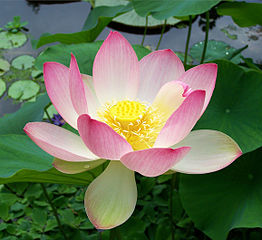
Q:
What is the botanical name for water chestnut? Will it grow here? Are there other water plants that have edible tubers which will thrive in the Pacific Northwest? What about edible lotus root, from Chinese lotus?
A: Chinese or Sacred lotus
(Nelumbo nucifera), pictured at right, is hardy in zones 4-10 and is considered invasive in some parts of parts of the midwestern and southeastern U.S. This
article in The Guardian by Mark Griffiths, author of "
The Lotus Quest", suggests growing it in a container in a conservatory or on a sunny deck. However, you may not want to harvest tubers from a lotus grown in a relatively small container, as the plant needs to be large enough to have a substantial system of linear growth in order to sacrifice some of its tubers for human consumption. According to the
Colorado Water Garden Society, "Lotus grow in a linear fashion, with a sequence of a tuber producing a leaf and perhaps a flower, then beginning another tuber to repeat the cycle...tuber, leaf, flower, tuber, leaf, flower, etc. Each terminal point produces a single leaf and flower and then sends out the next, new growth. Beneath the soil, lotus growth takes on one of two forms: runners and tubers. The Summer "runner" growth is thin and long (to 24"+)."
American yellow lotus
(Nelumbo lutea) also has edible tubers, but it can be an aggressive grower. If you are seeking out plants, be aware that there is sometimes identity confusion among
Nelumbo, Nymphaea, Nymphoides, and
Nuphar. In King County, there are two common invasive water lilies that are sometimes mistaken for lotuses,
Nymphaea odorata and
Nymphoides peltata. While some of these water lilies have tubers that have been considered edible in times of famine, they are not a desirable food source.

The common name 'water chestnut' may refer to the edible corms of the Chinese water chestnut familiar from Asian cuisine
(Eleocharis dulcis), pictured here, which is in the sedge family (Cyperaceae), or to European water chestnut
(Trapa natans), which is in the loosestrife family (Lythraceae).
Eleocharis is not winter-hardy in our area (it requires zones 9-11).
Trapa natans is a noxious weed in Oregon and is on the
Washington State Noxious Weed quarantine list, so it is not a good choice if you are planning to grow your own aquatic plants. Green Deane's
Eat the Weeds webpage describes the differences between these plants.
This is an excerpt. For Rebecca's full answer, including information on wapato, see the Gardening Answers Knowledgebase entry.